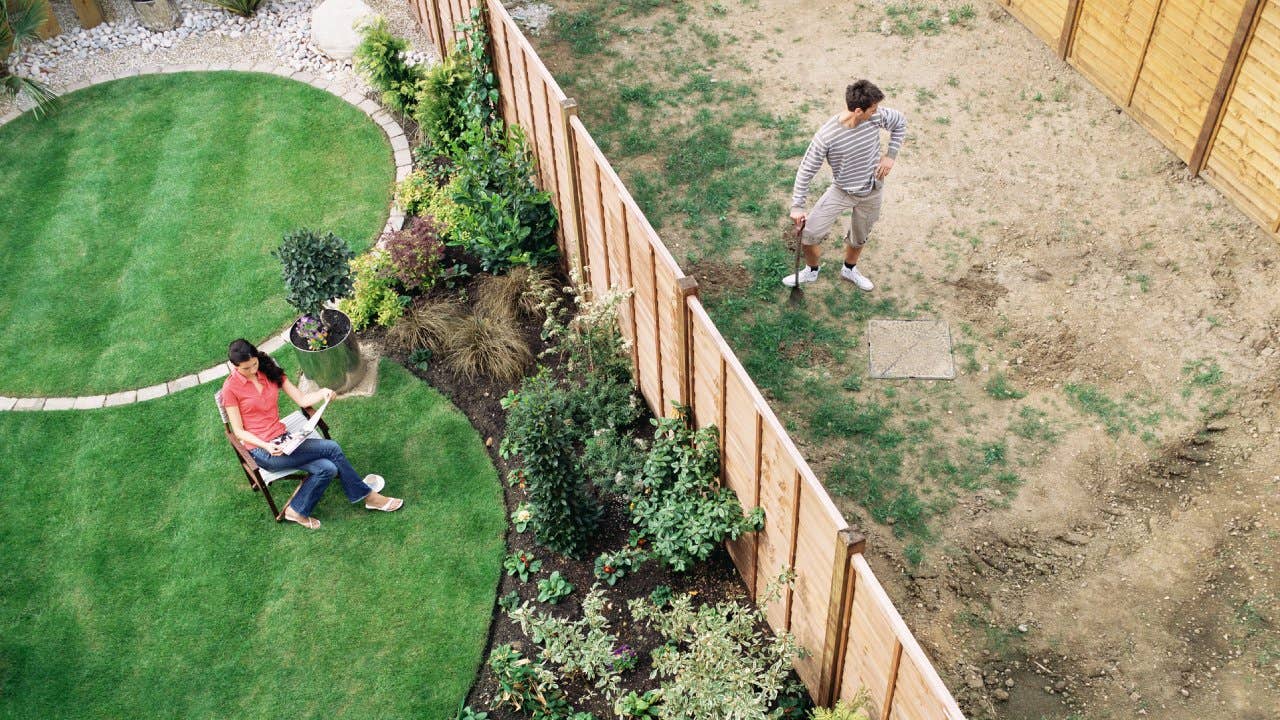What is encroachment?

The Bankrate promise
At Bankrate we strive to help you make smarter financial decisions. While we adhere to strict , this post may contain references to products from our partners. Here's an explanation for .
Encroachment in a real estate term that refers to an invasion of private property rights. It’s typically a literal, physical invasion: a structure or piece of infrastructure owned by one person that sits on or crosses the property line of another’s.
Encroachments can be as small as a garden bed planted along a fence or as large as an entire house addition jutting into a yard. They can be intentional or unintentional. Either way, they can affect property values and impede home sales.
What is encroachment in homeownership?
Often occurring along disputed or indistinct property lines or boundaries, encroachment happens when one homeowner constructs or extends a structure or feature on a neighbor’s lot or land, thus violating that neighbor’s property rights. An encroachment is any use of a neighboring property, usually within the bounds of a property line.
Generally referring to a fixture or object, “encroachment” sometimes refers more loosely to invasive behavior or property use (parking, gardening, storing trash cans, etc.), though strictly speaking, this is a different type of trespass (see “Encroachment vs easement” below).
Common examples of encroachment include:
- Your neighbor constructs a fence or enlarges a driveway on your lot
- Your neighbor builds a house addition or a landscaping element that crosses into your yard or lawn
- Overgrown trees, hedges, shrubs or gardens expand onto your land
Encroachment vs easement
“Encroachment” sometimes gets conflated with “easement,” another real estate reference. Both terms do deal with people making use of a property they don’t own, extending their rights to a degree.
However, while encroachment indicates unauthorized use, an easement refers to an agreed-upon use. Easements are rights of way established by the owner of property that allow people to use it or access it, or pass through it without harming it. Common examples of easements include a homeowner permitting a neighbor to cut across their backyard to get to the bus stop or to let a vegetable patch straddle the joint property line.
Reasons property owners encroach
Encroachment happens for a variety of reasons. One is that it’s relatively easy to do. Property boundaries are usually clearly marked — but on maps and blueprints, not in people’s minds. Shifts or erosion in land, the buildup of vegetation, and the passage of time itself can figuratively and even literally erode a sense of whose lot begins where.
Or a home may be built in a place where there are no clear property lines and the newcomer might, in good faith, assume that their property extends to the street or not realize that part of their residence, or the swimming pool they put in, is on the neighboring property.
In short, many encroachments are inadvertent. Others, however, are not. Whatever the reason, they can make for nasty neighborly relations.
What problems does encroachment cause?
First and foremost, encroachment can be a nuisance. It may involve physical obstacles like fences or shrubbery or sheds that impede the owner’s enjoyment or use of their land. It can also be a safety concern, or lead to increased costs for upkeep — like overgrown trees whose trespassing branches constantly drop leaves, fruit or nuts into the yard, necessitating hiring someone to sweep them up.
Next, encroachment can cause property values to decline. It can damage the physical integrity or appearance of a home, or shrink the livable space or grounds — effectively reducing the overall size of the property. These things all adversely affect the appeal of the home, along with its intrinsic worth.
And that, in turn, can impact the homeowner’s ability to price and sell the residence. A potential buyer would probably have concerns about the problems they could face with neighbors after they purchase the property. And their fears would not be just psychological.
If left unchecked or unaddressed, encroachments can turn into more serious issues, with legal consequences. Let someone use a property long enough, and though never officially authorized, their behavior could become legal, as if you had granted permission – something called a prescriptive easement or gaining title by adverse possession.
Or the longstanding encroachment could be seen as an encumbrance, a financial claim or a right that a non-owner has on a property of another. Encumbrances can cloud property titles. Buyers tend to shy away from homes without clear titles — it can be grounds for getting out of a purchase — and mortgage lenders don’t like them either. In a worst-case scenario, a loan applicant could lose their lender’s approval after the encroachment is discovered, meaning they may not be able to purchase the house after all.
Options to deal with encroachment
Encroachment can be tricky to deal with. But several options exist, in escalating degrees of formality.
- Know your grounds (literally). Figure out or refresh your memory of your property’s lines and boundaries. Even if you have your original plans and documents, commissioning a property survey isn’t the worst idea in the world — to ensure your info is totally up to date. (Based on its results, you could then stake your property, indicating the boundaries.) If you have a homeowner’s association (HOA), read up on your community’s rules.
- Talk to the encroaching party. Once armed with the facts and the docs, have a chat with your neighbor. Try to be amicable and reasonable, even if you’re totally in the right. Their trespass may have been inadvertent, after all. See if they can remove or alter the offending feature.
- Strike a deal. Assuming you can live with the encroachment, offer to sell that portion of the land to your neighbor. Or offer them an easement, and have them compensate you in some way for it. The easement can be recorded — make sure its size, location, permitted uses and other details are thoroughly described — in the certificate of title or other property documents, so the encroachment will not be considered an encumbrance.
- If it’s a matter of disputed property lines, file a claim with your title insurance company (if you have one). Unless the policy specifically excludes boundary disputes, this is the sort of thing they’re being paid to handle.
- Get legal counsel. If you can’t reach an agreement, seek out an attorney. They may recommend mediation or non-binding arbitration. Your HOA may offer provisions for such hearings too.
- File a lawsuit. The most drastic remedy, and the last-ditch one. Just bear in mind, going to court is expensive, time-consuming — and does not guarantee that you’ll prevail.
Related Articles



